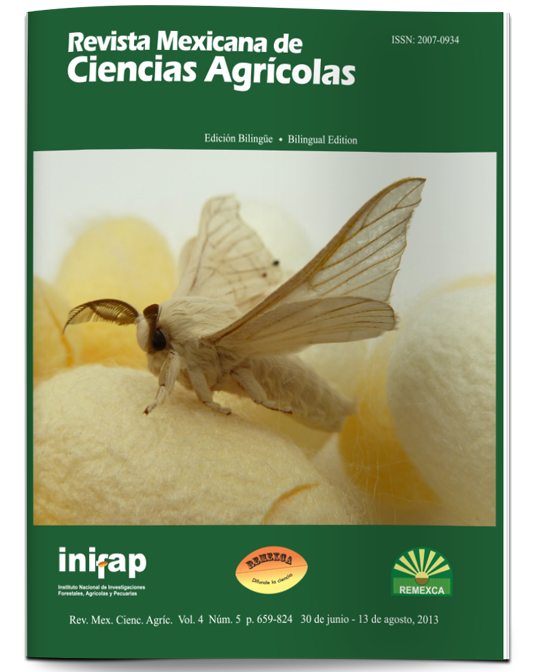Biological efficacy against Diaphorina citri Kuwayama (Hemiptera: Psyllidae) of chemical compounds applied to the soil and foliage in Citrus latifolia Tanaka
DOI:
https://doi.org/10.29312/remexca.v4i5.1168Keywords:
Diaphorina citri, Persian lime, chemical controlAbstract
The citrus acreage of Mexico exceeds 532 000 hectares. This area is endangered by the recent detection of the bacterium Candidatus Liberibacter asiaticus in some states and by the wide distribution of the vector Diaphorina citri. The aim of this study was to evaluate the efficiency against D. citri of chemical compounds applied to the soil and foliage in Persian lime. Two field evaluations were made during 2011 with applications of spirotetramat and imidacloprid to foliage and soil, and of spinosad and avermectin only to foliage. In the first evaluation, the spirotetramat (400 mL/ha) and the imidacloprid (300 mL ha-1), applied to foliage, caused a decrease of nymphs of 78.8%-93.54% three days after the application. The Imidacloprid (300 mL ha-1), applied to the soil, the spinosad (0.1 L ha-1), and the avermectin (0.1 L ha-1), had 69.8%, 70.6% and 61.6% less nymphs than the control treatment. In the second evaluation, imidacloprid, applied to the foliage, decreased the population of nymphs in shoots by 81.9%.The lowest average of nymphs per shoot in various sampling dates was obtained with the spirotetramat and imidacloprid treatments applied to foliage; 89.6% and 87.5% less than the control, respectively. Of the products evaluated, the spirotetramat and the imidacloprid, when applied to foliage, exerted the greatest effect against D. citri.
Downloads
Downloads
Published
How to Cite
Issue
Section
License
The authors who publish in Revista Mexicana de Ciencias Agrícolas accept the following conditions:
In accordance with copyright laws, Revista Mexicana de Ciencias Agrícolas recognizes and respects the authors’ moral right and ownership of property rights which will be transferred to the journal for dissemination in open access. Invariably, all the authors have to sign a letter of transfer of property rights and of originality of the article to Instituto Nacional de Investigaciones Forestales, Agrícolas y Pecuarias (INIFAP) [National Institute of Forestry, Agricultural and Livestock Research]. The author(s) must pay a fee for the reception of articles before proceeding to editorial review.
All the texts published by Revista Mexicana de Ciencias Agrícolas —with no exception— are distributed under a Creative Commons License Attribution-NonCommercial 4.0 International (CC BY-NC 4.0), which allows third parties to use the publication as long as the work’s authorship and its first publication in this journal are mentioned.
The author(s) can enter into independent and additional contractual agreements for the nonexclusive distribution of the version of the article published in Revista Mexicana de Ciencias Agrícolas (for example include it into an institutional repository or publish it in a book) as long as it is clearly and explicitly indicated that the work was published for the first time in Revista Mexicana de Ciencias Agrícolas.
For all the above, the authors shall send the Letter-transfer of Property Rights for the first publication duly filled in and signed by the author(s). This form must be sent as a PDF file to: revista_atm@yahoo.com.mx; cienciasagricola@inifap.gob.mx; remexca2017@gmail.
This work is licensed under a Creative Commons Attribution-Noncommercial 4.0 International license.



